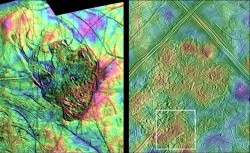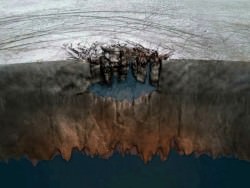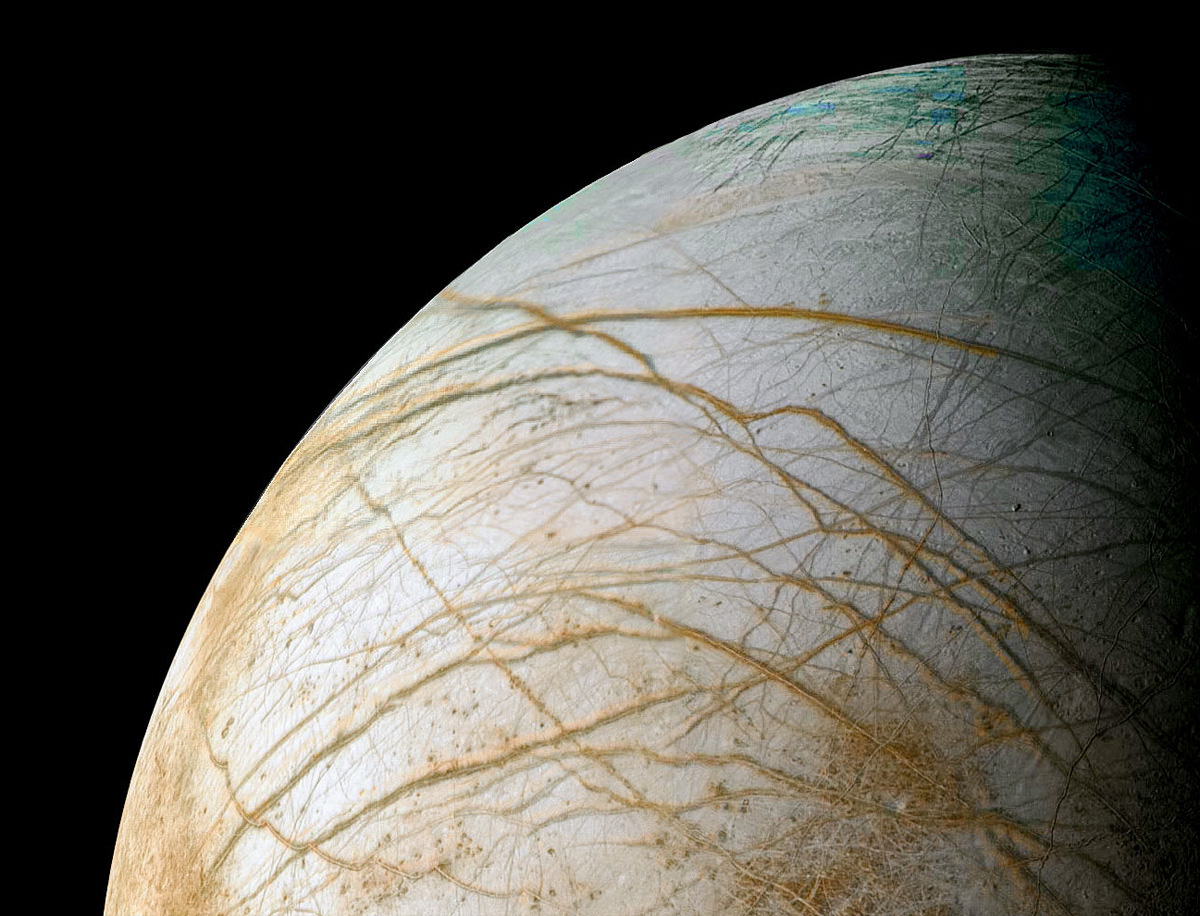[/caption]
New research on Jupiter’s ice-covered moon Europa indicates the presence of a subsurface lake buried beneath frozen mounds of huge jumbled chunks of ice. While it has long been believed that Europa’s ice lies atop a deep underground ocean, these new findings support the possibility of large pockets of liquid water being much closer to the moon’s surface — as well as energy from the Sun — and ultimately boosting the possibility it could contain life.
During a press conference today, November 16 at 1 p.m. EST, researchers Britney Schmidt, Tori Hoeler, Louise Prockter and Tom Wagner presented new theories concerning the creation of “chaos terrain” on Europa.
Chaos terrain is exactly what it sounds like: irregularly-shaped landforms and surface textures on a world. In the case of Europa, the terrain is made of water ice that evidence shows has been loosened by the motion of liquid water beneath, expanded, and then has refrozen into hills and jagged mounds.

These mounds are visible in topographic data acquired by the Galileo spacecraft in 1998.
During the presentation a good analogy for the processes at work on Europa was made by Britney Schmidt, a postdoctoral fellow at the Institute for Geophysics, University of Texas at Austin and lead author of the paper. She demonstrated the formation of Europa’s “mosh pit of icebergs” using a drinking glass partially filled with ice cubes. When water was added to the glass, the ice cubes naturally rose up and shifted orientation. Should the water beneath them refreeze, as it would in the frigid environments found in the Jovian system, the ice cubes would be held fast in their new expanded, “chaotic” positions.
“Now we see evidence that it’s a thick ice shell that can mix vigorously, and new evidence for giant shallow lakes. That could make Europa and its ocean more habitable.”
– Britney Schmidt, lead author
Similar processes have also been seen occurring on Earth, both in Antarctica along the edges of ice shelves and in Greenland, where glaciers continually break apart and flow into the sea – often rolling over themselves and each other in the process.

The importance of these findings is that scientists finally have a model that demonstrates how Europa’s deep liquid ocean interacts with the ice near its surface in such a way as to allow for the transportation of energy and nutrients.
“This is the first time that anyone has come up with an end-to-end model that explains what we see on the surface,” said APL senior planetary scientist Louise Prockter.
With such strong evidence for this process, the likelihood that Europa could harbor environments friendly to life goes up dramatically.
“The potential for exchange of material between the surface and subsurface is a big key for astrobiology,” said Wes Patterson, a planetary scientist at the Johns Hopkins University Applied Physics Laboratory in Laurel, Md., and a co-author of the study. “Europa’s subsurface harbors much of what we believe is necessary for life but chemical nutrients found at the surface are likely vital for driving biology.”
Although the research favors the existence of these lakes, however, confirmation of such has not yet been found. That will require a future mission to Europa and the direct investigation of its icy surface – and what lies beneath.
Luckily a Europa mission was recently rated as one of the highest priority flagship missions by the National Research Council’s Planetary Science Decadal Survey and is currently being studied by NASA.
“If we’re ever to send a landed mission to Europa, these areas would be great places to study,” Prockter said.
Read more about this discovery in the Johns Hopkins University Applied Physics Laboratory press release, or in the NASA news release here. Also, watch the full conference recorded on Ustream below:


Gah, stop saying it may harbor life and get there already! We’ve been saying this for the past 10 years. It sucks that NASA’s funding is so shitty.
10 years? Remember 2010: Odyssey Two? 1982…
But then hey, remember what HAL said… 🙂
It would certainly be very ambitions (and EXPENSIVE) to send a probe to Europa that could melt down through the ice and explore the watery depths below. But what about just retrieving a sample of that reddish snow along one of those cracks? If we could bring such a sample back to Earth for some microscopic analysis, I’ll bet it would answer a LOT of questions.
Too bad that with the budgetary crisis that the world is experiencing, the space faring nations can’t all get together and pool the limited resources each have. Some great ventures could be within reach and soon with each country’s science and engineering prowess. Europa would be the next great target. Forget manned planetary landings, that will come latter. Lets develop some real far out robotics and remote science lab experiments and see what’s really in our own back yard beyond the moon and mars.
It’s a very real prospect that the James Web project could very well be put on the shelf for who knows how long. Mismanaged as it was, it is close to flying and an injection from the global space community is needed. We would all benefit from it’s discoveries.
Taking nothing away from China’s ambition, a duplicate of a manned station in LEO is certainly a waste and I have to wonder what more can be accomplished? If only we could work together, with their resources, beyond LEO would be sooner rather than later. Come on Earthlings, we have to get together to maximize our potential as a species.
Sorry for sounding Pollyanna with rose coloured glasses.
IMO, that would be a waste of a trip. We could send a submarine to Europa for about the cost of Curiosity, and if we started now it could be done in five years.
I don’t think we yet have the capability to build sample return probes for such a distant and large body. It would require an awful lot of fuel. It would probabyl be easier to send the analysis equipment there.
Because of the ice layer, it seems like the search for non-Terrestrial life is better prioritized at Mars, Titan and Enceladus.
Are you kidding? Enceladus also is covered with ice and doesn’t have a global ocean. It’s far less likely to harbor life than Europa.
To explore beneath the ice surface of Europa would require a large and complex operation comparable to drilling for oil. This would have to be done in the vacuum and cold of Europa’s surface. I suspect this would also have to be done with astronauts as well. Enceladus appears to be similar to Europa, albeit smaller, but it has geyser vents which shoot material into space. A flyby through the geyser vent could collect samples for analysis. This would be considerably less expensive.
LC
No problemo! Just send Bruce Willis & Co.! 😉
1st AN orbiter with ground penetrating radar to ascertain ice surface features above (thickness, density etc.) and water depth below a prospective life bearing water body. Once a target is selected, we send AN ice penetrating projectile (entry speed and angle calc’d based on radar results so as not bury it in the floor below). Attached to the projectile is a pod containing an array of miniature (battery powered?) submersibles which would be released following penetration. Many and miniature for redundancy and to reduce size and complexity of a single probe. After performing their respective science sampling experiments (maybe even video!), their results would be transmitted up to the orbiter which would then relay the data back to earth. Simple no?
Yea it’s me, Pollyanna… grin
The subsurface water pockets may be kilometers down. It is theorized that Enceladus’s subsurface Ocean may be dozens of kilometers below the surface. No probe could survive the impact necessary. a drilling or “melting operation will be necessary. No project has ever managed to go even a fraction of this distance, even on Earth.
A nuclear powered melting craft may be able to go deep enough to reach these possible bodies of water. Return samples or submersibles would make this a risky and expensive endeavor.
I would like to see some kind of mission to these ice worlds.
Thanks Fred, I interpreted the article as saying the chaotic surface dynamics would provide for variations in surface cracks/openings as well as ice thinning/melting. The orbiter with ground penetrating radar would identify those potential entry points.
But it has been caught in the act of spraying salt-water into space through surface cracks. It’s definitely a contender.
No, these results shows a growing problem to be acute (oxygen poisoning of abiogenesis processes). Unfortunately this darken the prospects for inhabited ice worlds close to giants like Jupiter.
Enceladus is likely the prototype for inhabited ice worlds:
– Saturn’s radiation belt is much weaker and likely not the same problem as source of oxidizers.
– Enceladus doesn’t seem to have the chaotic terrain of Europa, so no convection of oxidizers.
– It has a vast ocean, perhaps a global ocean, which is at least 100 Ma [million year] old, likely enough for abiogenesis.
– The ocean is known to have contact with organic containing ices in the pockets that sources the plumes. These organics has been observed by Cassini.
– It is believed the ocean has contact with the minerals of the core.
– The liquids and plumes tells of a large energy flow.
So everything what we believe is needed for abiogenesis and life seems present for Enceladus. Very little is known of Europa, and this latest result is a problem. See my other comment above for the details why.
And FWIW I agree with lcrowell on the Enceladus mission, more on that in the above comment.
Enceladus is at least thought to have a large subsurface “sea” beneath the south pole where the geysers are. The composition is similar to ocean water on Earth, based on direct analysis by Cassini of the water vapour in the plumes which are also now known to contain a variety of simple-complex organic molecules. For me, that puts it on a par with Europa.
if the surface is minus 200+ how would it react to something landing on it. eg hot thruster from an engine. Doubt I’ll ever know in my life time.
Well, the moon has virtually no atmosphere*, so burning propellant would dissipate very fast. There wouldn’t be much direct conduction at all. But the surface would still absorb a lot of EM radiation from the thrusters, and it would do what most materials do when heated: warm up, melt, burn, or explode. In Europa’s case, the surface is mostly ice, so it would melt and probably sublimate.
*what little there is is oxygen… I wonder if there’s enough to harness it for fuel?
I can’t believe that we’re not making exploration of Europa a top space priority. Everywhere on Earth where there’s water there’s also life.
POLL: Do you think there is life on Europa?
Vote: http://www.wepolls.com/p/5116925
That doesn’t mean that everywhere in the universe there’s water there’s also life… life requires more than just water.
Would it not be awful, if an expensive future probe mission to the Jovian moon was in its final, successful descent phase of journey, filling Mission Controllers with eager anticipation, when, as the landing thrusters shut-off at touch-down on the designated “Chaos Terrain” site, the lander is swallowed-up in a slushy expanse of water and ice. (Now, if it were equipped with floaters, and/or engineered for submersible, high-pressure operation, that could present a risky, but fortuitous opportunity).
Alternatively, imagine the spacecraft actually makes a soft landing on a frozen, level surface, and begins its investigations, through hours and days. Then, ominous forewarning signs from tremors are signaled back from station Europa, before the hapless robot emissary is overturned by a fracturing, slushing thaw from the subterranean depths, or crushed by a massive shifting “iceberg”.
____
According to one source “This ocean is deep enough to cover the whole surface of Europa and contains more liquid water than all of Earth’s oceans combined.” If that is accurate, it is astonishing. That Jupiter world has an equatorial radius of 1,569 km — smaller than Earth’s Moon (1,737.1 km)!
Swap that probe for a manned module and you have yourself a movie!
They should just swap the military and Nasa budgets over, then we’d be able to explore all the interesting places
hah! that’d work.
send swarms.
If a sample mission could get to Europa, and we’ve sent enough to do that right…then the surface is mostly ice…hydrogen and oxygen which happen to make great propellants! It could mine, warm, distill and electrically break the bonds to create enough fuel to get back. Although, I think if you can get men to the moon and back that it should be fairly comparable if not easier to get to Europa and back with no life support systems and only the weight of a liter or two of slush. Planetary boosts go a long way to speeding and steering a well timed ship.
Despite the excitement from the planetary scientists, for astrobiologists this is a downer I would think. Europa gets oxygen and hydrogen peroxide from breakdown of surface ice in the presence of Jupiter radiation belts. The so called nutrients of oxygen and hydrogen peroxide are poisonous for reducing abiogenesis processes.
Earlier models put the time of oxygen convecting down malleable ice to ~ 2 Ma [million years], which _may_ be enough to evolve protocells which putatively can adapt to oxygen. That is if one rather unrealistically assume that the new frozen ice after Europa formation formed before oxygen production started in earnest.
However this new model convects oxygen with other nutrients down much faster, first to the water pockets under the chaotic terrain, then to the whole ocean. Sufficient amounts would extinguish abiogenesis.*
Even before that, it would be much simpler, cheaper, faster to have a probe orbit Saturn to collect enough samples from Enceladus plumes until they can be transported to our laboratories by a return capsule.
Since we now know how Titan’s atmosphere works, we could feasibly use it for aerobraking into orbit in the same way some proposed missions to Titan has entertained to cheapen the project. Probe main engine delta-v effort would simply be leaving Earth orbit. In short, a really cheap mission to test for life compared with all others including Mars.
———————
* There are two problems here, of oxidizing chemistry and of poisonous oxygen in particular.
Chemical evolution is known to be orders of magnitude more productive and diverse under reducing conditions than neutral or oxidizing. Hydrothermal vents can locally turn an oxidizing ocean to a reducing vent flow by redox reactions in the crust. This is what may have happened on a seemingly near neutral CO2 dominated Earth.
However, that heat flow should make oxygen even more aggressive on biochemicals and biochemical systems. Cyanobacteria and plasmids can use a _triple_ (!) layer of _double_ membranes to avoid oxygen damage of sensitive metabolism. I.e. 6 layers of modern membrane biopolymers are needed in places as shield against reactive oxygen.
Excellent article! It is much better and informative than JPLs news release.
Thanks!